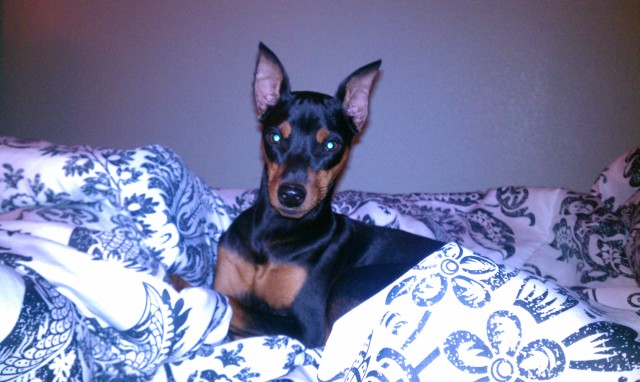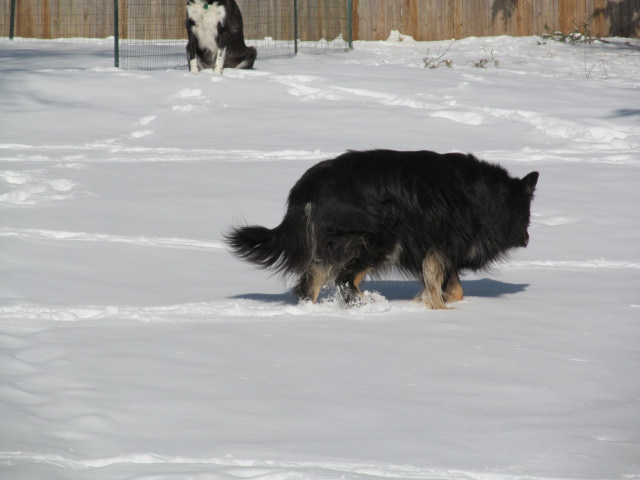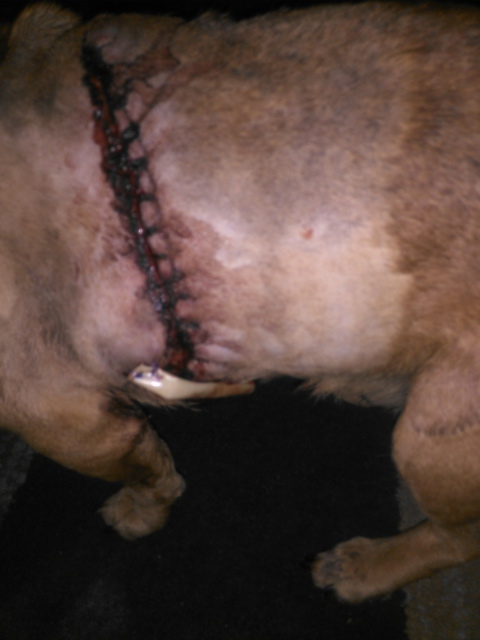QuestionHi there, we have two miniature schnauzers of 8 months and no children. They are very socialised and love walking off lead in the park and are happy when visiting other peoples' houses etc. The only problem we have is when other dogs or children come into our home - they bark and get very protective of their space and toys. How do I stop this and let them know that these people and dogs are fine?
Answer
Hi Penelope ,
Many dogs react strongly to the sound of the doorbell, and from there things go down hill really fast. By the time you might arrive at the door to answer it, your dogs may already be in such a lather that they can't think straight! You might have actually taught our dogs to behave this way because we wind up rushing to the door in an excited state, and your dogs have picked up on this.
The doorbell has become such a negative stimulus to the dog because it always represents something scary is about to come through the door! What has worked well is:
(1) putting an "out of order" sign on the doorbell
(2) asking an expected visitor to call right before they arrive at the driveway. This way your have time to put the dogs in a nice quiet room with a filled Kong toys or a healthy chew toys (such as bully stick or veggie Nylabone).
Train your dogs beforehand to go into this room a throughout the day. First put them in there and stay with them for about 15 minutes. Each time you put them in there, stay less and less, and get them used to being in the room and feeling good about being in there. Have a TV or radio on for company. Then, when you know someone is coming, they'll be very willing to go into this safe room without an "argument."
Now you can go and let your visitor enter your home without having the doorbell ring or someone knocking on the door. Have this person sit down and get comfortable and ask them if they'd be willing to help you socialize your dog. The best place to sit with your visitor at the kitchen table. Have lots of dog treats ready and place them on the table. When the dogs enters the room, have your guest sit there like a statue. Give your visitor the following instructions:
1. Do not make eye contact with the dog.
2. Do not speak to the dog.
3. Do not reach a hand toward the dog.
4. Do not try to pet the dog.
Bring your dogs into the kitchen on their leashes, and try to keep the leash as loose as possible. Avoid holding the leash with a death-grip, or your dogs will sense that you're feeling nervous and they'll respond in kind! Have a seat yourself at the kitchen table, but at a distance from your visitor. Have your dogs sit right beside you while you continue to hold their leashes. When you sense that they're calming down and not feeling anxious about the visitor, allow them to approach this person. If the dogs then wants to sniff and investigate this person, here are additional instructions to give your visitor:
1. Begin slowly and quietly dropping treats on the floor for the dogs to eat (provide soft and very tasty food treats; cheese, bits of lunch meat, freeze-dried liver, bits of chicken, bits of hot dogs, etc. If the dogs eat the treats, you can be relatively certain that their stress levels are lowered. If they chooses not to eat, they will still be quite nervous.
2. If the dogs eat, after a few minutes, tell your visitor to put a treat in an open palm and put that hand down by their side (still no eye contact or talking to the dogs). If the dogs eat the treat from this person's hand, you're probably on your way to a good introduction.
3. Once the dogs are accepting hand-fed treats, your visitor can start to speak softly to the dog. Your visitor can begin looking at the dog, but not directly in the eyes. *You* be the judge as to whether your dogs should continue staying in the room with this person for the duration of the visit. If your dogs seem to be relaxing and gaining trust in this person, that's a very good thing. If your dogs starts to back away from this person, it would probably be best to give him a break in that safe room you've created for them. They can always come back out in a little while for a re-introduction.
4. For first-time visits with anyone, I would suggest that you not encourage petting. Petting is not always seen by every dog as rewarding! When dogs are fearful, they may resort to nipping a person for trying to touch them. You always want to avoid having your dogs behave in an inappropriate way with anyone. Each time they're allowed to behave in an inappropriate way with people, they're learning to strengthen those bad habits. Both you and your visitor should praise your dogs to the skies for showing friendly behaviors.
5. Instruct your visitor to not get up without first telling you that they're going to get up. If someone wants to get up or leave the house, *first* call your dogs over to you, and take them into another room. Keep then facing *you* and get his attention focused on you! Get their attention by feeding those delicious treats continuously until the person is gone. Nervous dogs generally get nervous again as soon as the stranger stands up and moves around. That's probably because the dogs doesn't know what this person is going to do. If you make a practice of feeding your dogs when people leave, they'll begin to change their association of that behavior from negative to positive because of the anticipation of food.
The more visitors you introduce your dogs to (on a one-to-one basis), the better they'll become at accepting strangers to the house. What you're doing here is changing your dog's associations with strangers. At first it looks like: STRANGERS = SCARY STIMULUS-BAD FEELINGS. After you work on this for awhile, it will look like: STRANGERS = GOOD FOOD-GOOD FEELINGS. Your dogs will begin to look forward to meeting people at home because they will predict "good things happen."
Be patient! This will not happen overnight! But your dogs are still fairly young, this would be a harder habit to break if it was going on for years and years.
Of course, this is pretty generalized advice. I've never seen your dogs in action. If nothing seems to help you get control of this situation, you need to have a dog trainer visit your home and evaluate your dogs. Sometimes there just isn't a substitute for the help of a live-and-in-person professional. Your vet or boarding kennel may be able to recommend a dog trainer, or you can find on in the yellow pages, under dog obedience.
Best of luck,
Patti

 Dog Breed.
Question
Recent photo this week
Hello,
I saw that you
Dog Breed.
Question
Recent photo this week
Hello,
I saw that you
 st bernard archy.
QuestionQUESTION: I have a four year old st bernard. I
st bernard archy.
QuestionQUESTION: I have a four year old st bernard. I
 My miniature pinscher :)
Question
Chanel
I had a miniature pinscher of 8
My miniature pinscher :)
Question
Chanel
I had a miniature pinscher of 8
 Old dog, old owner, grooming issues
Question
Jessis
I have a 13-yr-old German shephe
Old dog, old owner, grooming issues
Question
Jessis
I have a 13-yr-old German shephe
 tumor on my dog
Question
stitched up second tim tumor
My d
tumor on my dog
Question
stitched up second tim tumor
My d